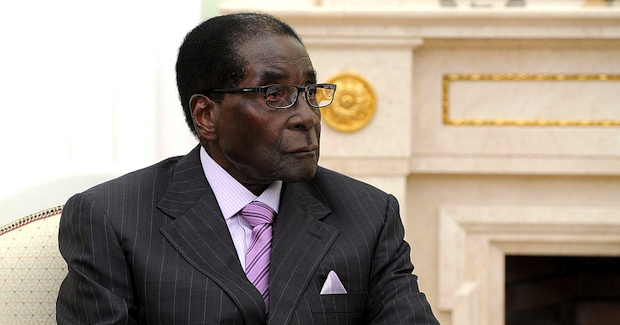Zimbabwe's Problems Need Local Solutions

Zimbabwe is restless as the government freezes salaries and makes further cuts to public spending on scarce social services. The worsening economic crisis has prompted accusations of government mismanagement and sparked major anti-government protests. However, external interventions are not the answer and indigenous solutions must be developed.
In one of many bad signs for the economy, about 95 per cent of Zimbabweans are working in the informal sector. People are using debit cards because of the country’s severe cash shortage and like during the Great Recession of 2008, many are falling back on bartering. The country is also a recipient of food aid from the UN World Food Programme and the El Niño-induced drought has severely affected harvests.
Amid these challenges, Zimbabweans are calling for the country’s leader, President Robert Mugabe, to step down. The ZANU-PF government has, in turn, responded with a heavy hand. With mounting uncertainty about the country’s economic future, some honesty is needed about the causes of the country’s protracted economic crisis.
On 23 October 2012, the International Monetary Fund (IMF) relaxed restrictions on technical assistance available to Zimbabwe. These restrictions were on access to IMF financing and advice on how to strengthen the country’s institutional capacity to promote economic growth. Their relaxation led to IMF staff-monitored programmes (SMPs), the last of which was completed in December 2015. The SMPs looked to “support Zimbabwe’s formulation and implementation of a comprehensive adjustment and structural reform program that can be monitored by Fund staff.”
Christian Beddies, the IMF’s resident representative in the country has been monitoring the implementation of the proposed reforms. Zimbabwe’s Minister of Finance and Economic Development, Patrick Chinamasa, stated that support provided under the SMPs has, “played a pivotal role in our efforts to transform our economy, normalise relations with the international community, and eventually access IMF financial resources.”
Zimbabwe’s economy has been struggling for more than two decades and there is a myriad of causes. The SMPs looked to address some of these problems like the country’s external debt and the decline in its terms of trade due to the appreciation of the US dollar. The resulting reforms have included civil service cuts, policies to improve the management of domestic and external debt, introducing new indigenisation and land reform policies designed to improve the business environment (e.g. introduction of 99-year land leases), and pursuing private-sector led growth. The latter is promoted with the interests of Western investors in mind.
SMPs are also behind the planned introduction of the controversial bond notes. These are paper notes backed by the African Export-Import Bank that will be interchangeable with the US dollar. However, Zimbabweans distrust these, fearing the reintroduction of the local currency. The SMPs are, therefore, important developments to keep in mind when considering the growing unrest in the country.
Zimbabwe’s leaders want to clear US$1.8 billion (A$2.35 billion) of their debt with three creditors—the IMF, the World Bank, and the African Development Bank—in order to unlock fresh capital. The initial deadline for the clearance of these arrears was June 2016, which was rescheduled for October. The debt-financing burden facing Zimbabwe is said to be due primarily to shortcomings in leadership and the El-Niño-induced drought. However, Zimbabwe’s problems can also be attributed to external intervention.
Some of these introduced challenges can be traced back to the Economic Structural Adjustment Programmes (ESAP) of the 1990s. These undermined the macroeconomic stability the country enjoyed in the 1980s. ESAP brought the age-old World Bank and IMF prescriptions, like a reduction of the government deficit, civil service reform and shedding of public enterprises. This was in addition to the devaluation of the Zimbabwean dollar which paved the way for today’s multi-currency system. Consequently, Zimbabwe borrowed a lot of money from the international financial institutions and other international donors which was “aimed at supporting the country’s balance of payments and government’s plans for substantial private sector infrastructural development.” Importantly, this was done at a time when grassroots land occupation movements were peaking due to inadequate post-independence land reform measures and deteriorating standards of living.
When Zimbabwe achieved independence in 1980, the Lancaster House Constitution of 1979 mandated willing-seller/willing-buyer land redistribution strategies. These maintained colonial land and economic relations. Under this arrangement, Britain provided funds for the ZANU-PF government to compensate white farmers whose farms were to be redistributed at an agreed price.
Land hunger, a lack of basic services and poverty due to ESAP-sanctioned privatisation eventually led the ZANU-PF government to appropriate the grassroots land occupation movement which had been underway since independence, by introducing the much maligned Fast Track Land Reform Programme (FTLRP) in 2000.Land could now be taken without compensating white farmers. FTRLP has been misrepresented as a racist assault against the white population. In truth, it responded to a need for economic decolonisation, which was frustrated by the white minority’s unwillingness, supported by the international community, to share land equitably and the government’s mismanagement of the redistribution process. FTLRP resulted in economic sanctions from Western countries and the international financial institutions (IFIs), who suspended lending to the country.
In September 2007, as the wheels of the 2008 recession were in motion, Parliament passed the Indigenisation and Economic Empowerment Act (IEEA). It mandated that, “at least 51 per cent of the shares of every public company and any other business shall be owned by indigenous Zimbabweans.” Compounded with the 2008 recession, Zimbabwe experienced capital flight, hyperinflation and a liquidity crunch. The West and IFIs called for a return to good governance and the normalisation of relations, meaning the period of ESAP before FTLRP and indigenisation policies. Both of the latter are under attack today due to the SMP, the latest iteration of western-backed World Bank and IMF structural reforms. As life gets harder for Zimbabweans, we must be honest about the causes behind their troubles.
Further cuts to public expenditure for scarce social services and freezing salaries, drastically reduces the poor’s purchasing power as austerity means higher prices for basic commodities. The SMPs, like the structural adjustments of the 1990s, will increase land hunger, food insecurity, indebtedness, and decrease Zimbabwe’s capacity to plan and implement alternative policies based on local knowledge and resources. ‘Normalising’ relations and ‘re-engagement’ with the international community are sad euphemisms for the continuing economic destabilisation of Zimbabwe. It is about time African leaders questioned external prescriptions of good governance and created their own models for national prosperity and security.
Tinashe Jakwa is studying for a Master of International Relations student at the University of Western Australia.
This article is published under a Creative Commons Licence and may be republished with attribution.





